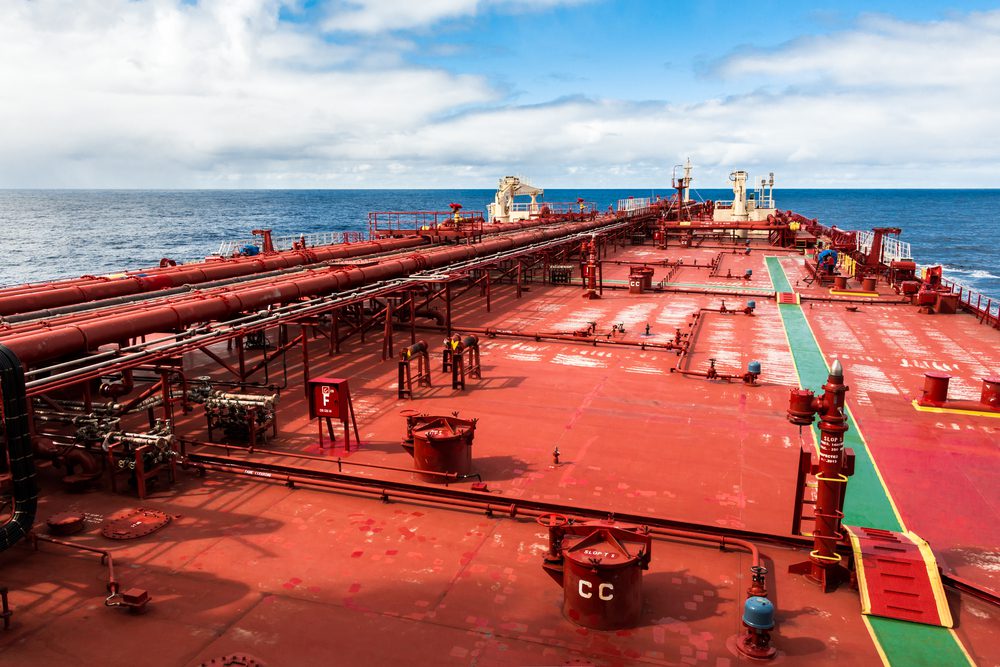Anatoly Menzhiliy / Shutterstock
By Anthony DiPaola, Julian Lee and Alex Longley (Bloomberg) — Iran is starting to store oil on its fleet of supertankers again as impending U.S. sanctions force the Persian Gulf country to revive a strategy it deployed under previous curbs.
The build-up of crude in floating storage offshore Iran signals the effectiveness of the new sanctions imposed by U.S. President Donald Trump on the Persian Gulf country’s oil. The measures are due to start in early November, but buyers including France, South Korea and others have already started to cut back sharply.
“We can expect floating storage to increase under the growing impact of U.S. sanctions in the coming months,” Harry Tchilinguirian, head of commodity-markets strategy at BNP Paribas SA, said from London.
So far, most of the ships in question — all of which are Iranian owned — have only been holding crude at sea for a few weeks, rather than for months at a time as they did during 2012-2016 sanctions, tanker tracking compiled by Bloomberg show. Almost all Iran’s main customers purchased fewer Iranian barrels in August than they did in April, the month before Trump said sanctions were being reimposed.
At least five full crude tankers have anchored off the Iranian coast over the past two-and-a-half weeks. Two holding condensate, a light oil produced at Iran’s natural gas fields, have been idling for weeks off Dubai.
Trump is trying to cut off Iran’s oil exports to deprive the third-biggest member of the Organization of Petroleum Exporting Countries of income. In May, he pulled out of a 2015 pact that eased sanctions in return for Iran slowing its nuclear program, describing the deal as “rotten to its core” and failing to address the country’s ballistic missile testing or funding of terror groups. Buyers who defy the U.S. sanctions risk having their banks frozen out of the American financial system.
Iran’s Floating Storage: By Vessel Class, Date loaded, Cargo Volume (barrels), Location, Name
- By Vessel Class, Date loaded, Cargo Volume (barrels), Location, Name
- VLCC 06-Aug, Condensate 2,000,000, Jebel Ali, Salina
- Suez 16-Aug, Condensate 1,000,000, Jebel Ali, Navarz
- VLCC 24-Aug, Crude 2,000,000, Kharg, Happiness I
- VLCC 01-Sep, Crude 2,000,000, Kharg, Humanity
- VLCC 03-Sep, Crude 1,000,000, Soroosh, Hedy
- VLCC 03-Sep, Crude 2,000,000, Kharg, Halti
- VLCC 06-Sep, Crude 2,000,000, Kharg
The Middle East country is not storing as much crude at sea as it did during previous sanctions, when tens of millions of barrels were held for months at a time. Nor have exports yet fallen by as much. Still, the buildup of floating storage underscores the challenges the country is facing to find buyers: customers like South Korea have completely halted imports from the country, while Europe’s refiners are scaling back.
Iran’s pumped about 3.7 million barrels a day on average since sanctions eased at the start of 2016, more than 1 million barrels a day above what it was producing when sanctions were at their toughest.
The tankers being used to store are owned by the state-run National Iranian Tanker Co. Tying up the country’s own vessels as floating storage could crimp its ability to export, since international tanker operators have found it increasingly difficult to get insurance for shipping Iranian cargoes. That’s made Iran more dependent on its own fleet.
“Iranian exports are falling fast,” Amrita Sen, chief oil analyst at Energy Aspects Ltd., said in a note to clients. Shipments are “set to average as little as 1.5 million barrels a day in September according to the preliminary loading program, compared to around 2.8 million barrels a day of oil exports in April and May,” she said.
© 2018 Bloomberg L.P

 Join The Club
Join The Club











